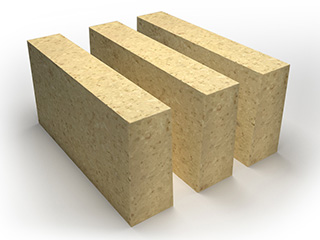High alumina bricks are a type of refractory brick made from high-purity alumina and other raw materials. They are commonly used in industrial applications such as steelmaking, cement production, and petrochemical processing due to their ability to withstand high temperatures and harsh chemical environments. However, not all high alumina bricks are created equal, and choosing the right type for your specific needs is crucial to ensuring optimal performance and longevity. In this article, we'll discuss some important factors to consider when selecting high alumina bricks.

1. Alumina Content
The alumina content of high alumina bricks can vary from 45% to 99%. Higher alumina content generally leads to higher refractoriness (ability to withstand high temperatures) and resistance to chemical attack. However, high alumina bricks with lower alumina content may be more cost-effective and suitable for less demanding applications.
2. Density
The density of high alumina bricks is an important factor in determining their strength and durability. Bricks with higher density are typically more resistant to abrasion and mechanical damage, and are less prone to cracking or spalling at high temperatures. However, high-density bricks may also be more expensive and difficult to shape or install.
3. Porosity
Porosity refers to the amount of empty space within a high alumina brick. Bricks with lower porosity are generally more resistant to chemical attack and erosion, but may be more prone to cracking or spalling due to thermal stress. Conversely, bricks with higher porosity may be more susceptible to chemical attack, but may also have better thermal shock resistance.
4. Thermal Conductivity
Thermal conductivity refers to a material's ability to conduct heat. High alumina bricks with lower thermal conductivity are generally more effective at insulating against heat loss or gain, making them suitable for use in furnace linings or other high-temperature applications. However, bricks with higher thermal conductivity may be more suitable for applications where heat needs to be transferred quickly, such as in the cooling zone of a cement kiln.
5. Chemical Composition
The chemical composition of high alumina bricks can vary depending on the raw materials used in their manufacture. Common additives include silica, magnesia, zirconia, and other refractory oxides. The presence of these additives can significantly impact the performance of high alumina bricks in terms of their refractoriness, thermal shock resistance, and resistance to chemical attack. Therefore, it is important to choose a brick with the appropriate chemical composition for your specific application.
6. Shape and Size
High alumina bricks come in a variety of shapes and sizes, including standard bricks, arch bricks, wedge bricks, and others. The shape and size of the brick can impact its performance in terms of thermal conductivity, thermal shock resistance, and overall durability. It is important to choose a brick that is the right shape and size for your specific application, taking into account factors such as the size and shape of the furnace, the temperature gradient within the furnace, and any mechanical stresses that the brick may be subjected to.
7. Installation Method
The method of installation can also impact the performance of high alumina bricks. Different installation methods, such as dry or wet mortar, can impact the porosity, density, and overall strength of the brick. Additionally, the use of proper techniques and materials during installation can help to prevent cracking, spalling, or other types of damage that can occur due to thermal stress or mechanical stresses.
In conclusion, choosing the right high alumina brick for your refractory needs requires careful consideration of factors such as alumina content, density, porosity, thermal conductivity, chemical composition, shape and size, and installation method. By taking the time to evaluate these factors and select the appropriate brick for your specific application, you can ensure optimal performance and longevity of your refractory system. It is also important to work with a reputable supplier who can provide expert advice on selecting the right high alumina brick and can ensure that the brick is of high quality and meets the necessary specifications.
Once you have selected the appropriate high alumina brick, it is important to maintain it properly to ensure its longevity and performance. This includes regular inspection and maintenance to identify and repair any damage or wear, as well as proper cleaning and sealing to prevent chemical attack and erosion.
In addition, it is important to have a contingency plan in place in case of unexpected failure or damage to the high alumina brick. This can include having spare bricks on hand, as well as developing a plan for emergency repairs or replacement.
In conclusion, high alumina bricks are an essential component of many industrial refractory systems, providing high-temperature resistance and chemical resistance. By selecting the right high alumina brick for your specific application and maintaining it properly, you can ensure optimal performance and longevity of your refractory system.
Contact: Mgr. Han
Phone: 0086-13589497465
Email: 1255953279@qq.com
Add: Industrial Area of Lingzi Town,Zichuan District,Zibo City, Shandong,China